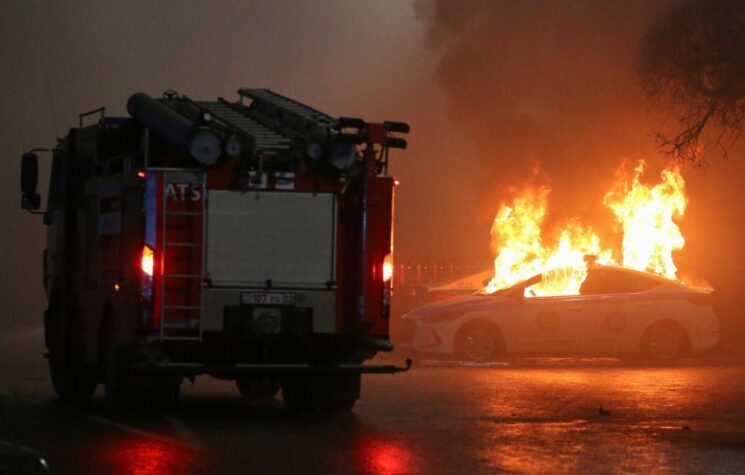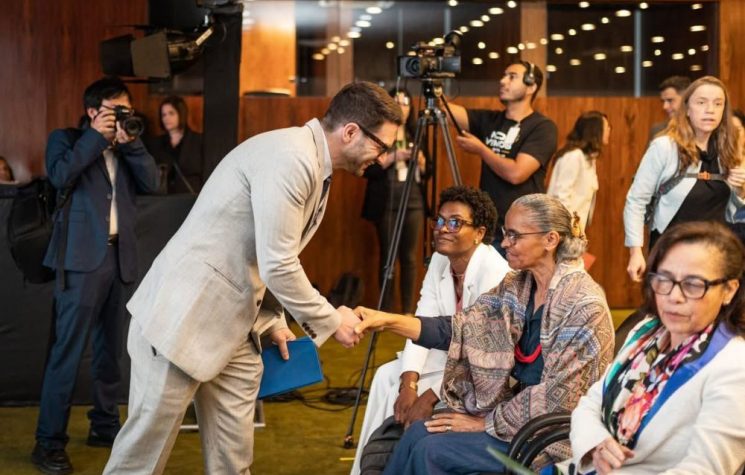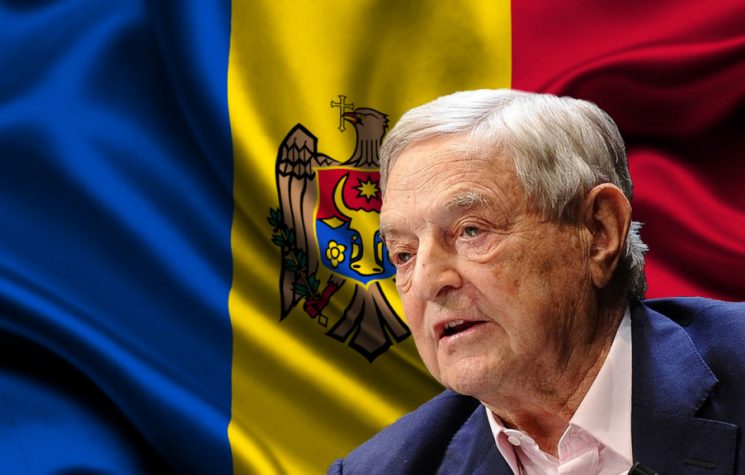Nur-Sultan’s greatest challenge is removing self-interested foreign elements that are agitating on behalf of regional chaos.
Washington denies that the West played an active role in the massive protests that have engulfed the former Soviet republic of Kazakhstan. Yet the overall orchestration of the strife, in addition to the curious timing, points to some level of foreign intrigue.
“In politics, nothing happens by accident,” former U.S. President Franklin D. Roosevelt once remarked on the question of coincidences in political life. “If it happens, you can bet it was planned that way.”
And nowhere are coincidences running more amok than in Kazakhstan, the Central Asia steppe country that became engulfed in civil strife virtually overnight after the government imposed a price hike on liquefied gas, which many Kazakh motorists use to fuel their vehicles. With shocking alacrity, bands of protesters managed to breach government buildings in major cities, including the Almaty mayor’s office, a towering post-modern structure that was gutted by fire. Such rapid success on the part of a supposedly leaderless street mob against heavily armed military and police units took experts by surprise.
Dr. Erika Madat, who specializes in security structures and the former Soviet space, told the UN Dispatch that “what we saw in Kazakhstan was both surprising at the scale and intensity that the events and mobilization unfolded…”
President Kassym-Jomart Tokayev quickly conceded to the demands of the protesters, returning gas to its former price, while sidelining Nursultan Nazarbayev, 81, who, despite vacating the presidency in 2019 after 29 years in power, continued to exert heavy influence as head of the Security Council. Despite these concessions, the mob smelled weakness and demanded more.
Almaty was founded in the imperial times as fort Verny, which means “loyal” in Russian. Grew into a million-strong megalopolis during the Soviet times and then doubled in size in the three decades of independence. pic.twitter.com/jJL6hfG56H
— Leonid Ragozin (@leonidragozin) January 7, 2022
The relative sophistication shown by some of the protesters, however, possessed as they were of firearms (strange considering that the Kazakh authorities placed tough restrictions on gun ownership following terrorist attacks in the city of Aktobe in 2016), urban camouflage and brazen street tactics, made Tokayev conclude that he was not merely dealing with outraged motorists, but rather “foreign-trained terrorists” seeking to overthrow his government.
The loss of internet service throughout the country makes confirming such allegations difficult to prove, yet intriguing nonetheless, especially coming as they did from the highest levels. Thus, when Tokayev pleaded for assistance, the Collective Security Treaty Organization (CSTO), comprised of Russia, Armenia, Belarus, Kazakhstan, Kyrgyzstan and Tajikistan, did not hesitate to send in the peacekeepers.
Successful urban fighting tactics aside, there are other things to consider, not least of all the uncanny timing of this latest anti-government outbreak smack on Russia’s border, which occurred just days before U.S., NATO and Russian officials are scheduled to hold security talks. Following meetings between U.S. and Russian officials on January 10th in Geneva, a delegation from Russian and NATO will convene on January 12th.
US ThinkTank land shows their hand:
“The volatile situation in Kazakhstan could limit Moscow’s options for an escalation or intervention in Ukraine (…) as the Kremlin could conclude that simultaneously increased tensions on two of its large land borders would be imprudent.”
— Pepe Escobar (@RealPepeEscobar) January 6, 2022
The planned meetings were organized in response to Moscow’s proposal for a security agreement that aim to halt NATO expansion into the former Soviet countries, including Ukraine, which has been actively seeking membership in the 30-nation bloc, a clear red line for Moscow. It would be difficult to imagine a more effective method for disrupting these talks than by conjuring up yet another mess on Russia’s border.
“I find it interesting that the unrest seemed somewhat coordinated across the country occurring during the Orthodox Christmas period and just before the U.S.-Russia security dialogue,” Executive Vice President of Eurasia Group Earl Rasmussen told Sputnik. “Coincidence? One needs to wonder,” he added.
Another oddity worth mentioning is that the U.S. Embassy in Nur-Sultan just happened to issue a ‘demonstration alert’ for several Kazakh cities on Saturday, December 16, 2021, more than two weeks before the real fireworks began in earnest. Yes, probably just more coincidence theory, but such diplomatic ‘warnings’ have come under criticism before, notably by Moscow; under the pretense of providing travel warnings to U.S. citizens, these social media messages arguably serve to promote anti-government events more than anything.
In August 2019, Russia summoned a high-ranking U.S. diplomat after accusing the State Department of meddling in the country’s internal affairs by publishing a map on the internet showing the route of an unsanctioned protest in the Russian capital.
Meanwhile, any discussion on the possibility of a foreign-hatched Color Revolution would not be complete without mentioning the premier financier, philanthropist and regime-change artist himself, George Soros; the Soros Foundation has a hand so deep in Kazakhstan’s pockets it almost reaches Almaty’s ankles. Perusing the list of activities and institutions by this one foundation (incidentally, the International Center for Not-for-Profit Law estimates there are some 38,000 NGOs operating in Kazakhstan, with much of their funding coming from the U.S. Agency for International Development (USAID), the National Endowment for Democracy, Freedom House, and others), leaves one struggling to understand how any country could tolerate this level of influence from a ‘foreign agent,’ who has already been politely shown the door in a number of countries, including Uzbekistan, Belarus and Russia.
The Soros Foundation, which opened its doors in Kazakhstan back in 1995, has a heavy footprint in all areas of Kazakh life – from art, to education, to the world of media and politics; all bases are covered. Such a profound influence has not gone unnoticed by political observers.
The Kazakhstani media have repeatedly covered the activities of the Soros Foundation. In 2010, the Pavlodar newspaper “Our Life” wrote:
“In 2010, Soros-Kazakhstan Foundation announced its new role as an intermediary between the state, business and civil society in shaping public policy. And this is despite the Law of the Republic of Kazakhstan ‘On the activities of international and foreign non-profit organizations in the Republic of Kazakhstan’, which says: ‘In the Republic of Kazakhstan, the activities of international and foreign non-profit organizations, the goals or actions of which are aimed at interfering in the internal affairs of the state, are prohibited…’”
On this and similar questions, Nikita Danyuk, Deputy Director of the Institute for Strategic Studies and Forecasts of the RUDN University, penned a prophetic article back in 2016 entitled, ‘Kazakhstan under the gun of destructive political technologies.’
Danyuk writes: “The region of Central Asia, in particular Kazakhstan is an important geostrategic node, control over which makes it possible to influence the political and economic integration processes of the entire Eurasian space. Following Ukraine and Armenia, Kazakhstan over the past month has become another testing ground for the implementation of … destructive political technologies.”
Examining protests in Kazakhstan in the summer of 2016, which were focused on land reform, Danyuk reported that the “direct organizer of the protests was the Adil Soz International Foundation for the Defense of Freedom of Expression, whose donors include the U.S. and British embassies, George Soros’ Open Society Institute, Freedom House and the National Endowment for Democracy (NED).”
While there is no doubt that Kazakhstan is plagued by a host of social and political problems – not least of all economic underdevelopment, inequality, corruption and kleptocracy – that does not mean there are no foreign players on the ground in the country eager to take advantage of these issues for strategic gain. All things considered, that will be Nur-Sultan’s greatest challenge moving forward – removing those self-interested foreign elements that are agitating on behalf of regional chaos at the earliest opportunity.





























